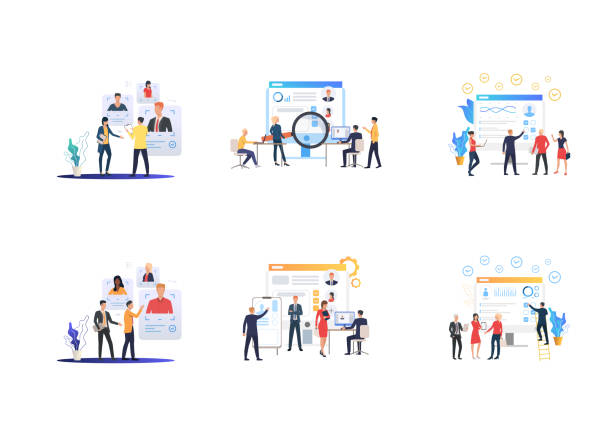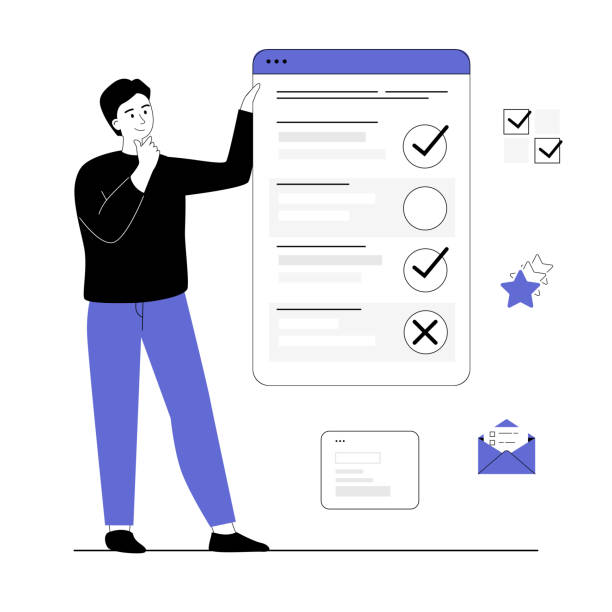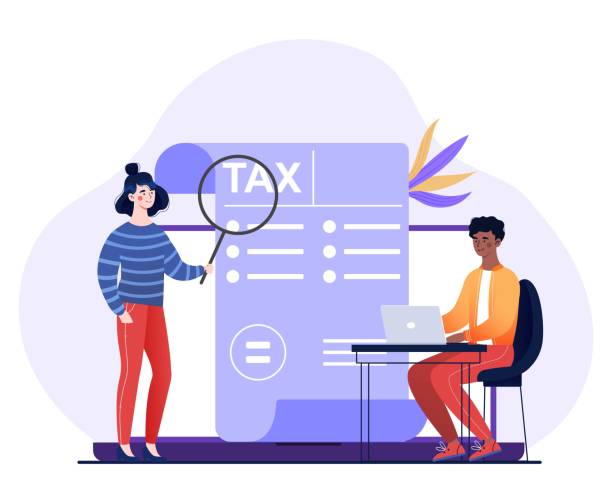Introduction to the Importance of User-Friendly Website Design and User Experience

In today’s digital world, where competition for audience attention is at its peak, #user_friendly_website_design is no longer considered a competitive advantage, but an undeniable necessity.
The success of any online business increasingly relies on its ability to provide an exceptional user experience (UX).
A website that a user can easily interact with, find the information they need, and complete their tasks simply, will not only have higher conversion rates but also foster customer loyalty.
This explanatory and educational approach shows audiences why investing in user-centric website design is justifiable from various economic and marketing perspectives.
A website with a complex user interface (UI), slow speed, or confusing navigation will quickly be abandoned by users, who will turn to competitors, regardless of how valuable its content may be.
Therefore, understanding the principles and correctly implementing this type of design is the cornerstone of a successful online presence.
The importance of this issue is such that even search engine algorithms consider user experience factors in website rankings.
A #SEO-friendly site is one that is optimized for both search engines and users.
Are you annoyed by losing customers because of your online store’s outdated appearance or slow speed? Rasaweb’s expert team solves these problems with professional online store design!
✅ Increase customer trust and brand credibility
✅ Stunning speed and excellent user experience
Get a free consultation with Rasaweb right now ⚡
Core Principles of UX and UI in Modern Website Design

At the heart of every user-friendly website design lie two key concepts: User Experience (UX) and User Interface (UI).
UX addresses all aspects of a user’s interaction with a product or service, in this case, a website.
This includes the user’s feelings, ease of use, efficiency, and overall satisfaction with the website.
In contrast, UI refers to the visual and interactive elements of a website: buttons, images, texts, forms, and everything the user sees and interacts with.
A specialized and educational design approach considers these two inseparable: good UI improves UX, and strong UX highlights the need for a functional and beautiful UI.
Adhering to the 10 Gestalt design principles and Nielsen’s 10 usability heuristics, including design consistency, appropriate feedback, user control and freedom, recognition rather than recall, and providing understandable error messages, are among the main pillars of this field.
A user-preferred site should anticipate both overt and hidden user needs and provide visual and functional solutions that exceed expectations.
In this regard, understanding user psychology and how they interact with digital content is crucial.
These principles help designers build a website that not only looks beautiful but also has high functionality and guides users to their goals.
Information Architecture and Intuitive Navigation in User-Friendly Website Design

One of the most important pillars of user-friendly website design is strong Information Architecture (IA) and an intuitive navigation system.
#Information_architecture refers to organizing and labeling website content in a way that users can easily find the information they need.
This includes the structure of menus, page categorization, and content hierarchy.
Without logical information architecture and #intuitive_navigation, even the best content can get lost.
Expert guidance in this area is that each page should have a clear goal, and the path to reaching that goal should be obvious to the user without much thought.
The use of sitemaps, breadcrumbs, and powerful internal search all help improve navigation.
The main goal is to reduce the user’s cognitive load.
A user-preferred site with optimal navigation allows users to move between different sections and reach their desired information without confusion.
This is especially crucial for large websites with a high volume of content.
Below is a simple table comparing good and bad navigation:
| Feature | Good Navigation (User-Friendly) | Bad Navigation (Not User-Friendly) |
|---|---|---|
| Simplicity and Clarity | Clear and concise menus | Cluttered and confusing menus |
| Consistency | Fixed menu position on all pages | Changing menu location on different pages |
| Visual Feedback | Highlighting the current page | Not showing user’s current position |
| Searchability | Presence of a powerful search box | Absence or weak search function |
This table provides an overview of what should be considered in website navigation design. Furthermore, continuous evaluation and usability testing with real users can reveal navigation weaknesses and contribute to continuous improvement.
Responsive Design and Mobile User Experience in the Digital Age

With the increasing use of smartphones and tablets to access the internet, responsive design and optimizing user experience (UX) for mobile have become a vital component of user-friendly website design.
#Responsive_design means creating a website that automatically adjusts its layout and content to the size of the user’s device screen.
This essential guidance and expertise ensure that users, whether on a desktop computer, tablet, or mobile phone, have a seamless and optimized experience.
Without responsive design, mobile users are forced to zoom, scroll horizontally, and struggle to click on small buttons, quickly leading to frustration and site abandonment.
Google also increasingly emphasizes the importance of mobile compatibility and considers it a significant factor in search result rankings.
Therefore, a user-preferred site should be designed with a ‘Mobile-First’ approach from the outset; meaning it is designed first for the smallest screens and then gradually expanded for larger screens.
This approach ensures that your site works well on any device and provides an excellent user experience, which in turn means greater customer loyalty and improved SEO.
Educational and specialized content in this field helps developers build flexible and beautiful websites using CSS Flexbox and Grid techniques.
Are you annoyed by losing customers because of your online store’s outdated appearance or slow speed? Rasaweb’s expert team solves these problems with professional online store design!
✅ Increase customer trust and brand credibility
✅ Stunning speed and excellent user experience
Get a free consultation with Rasaweb right now ⚡
Page Load Speed and Website Performance Optimization for Users

Website load speed is a critical and analytical factor in user-friendly website design.
#Website_speed not only directly impacts user experience but also significantly affects SEO rankings and conversion rates.
Studies have shown that even a few milliseconds delay in page loading can lead to a significant decrease in user visits and engagement.
A fast website demonstrates respect for the user’s time and creates a positive experience.
To achieve a website with optimal user performance, there are many expert guidelines: optimizing images with lossless compression, using browser caching, compressing CSS and JavaScript files, utilizing a Content Delivery Network (CDN), and choosing a powerful and optimized host.
These explanatory measures help improve loading times and prevent user frustration.
In today’s world, where users quickly access information, they expect websites to respond just as fast.
Therefore, continuous monitoring of website speed with tools like Google PageSpeed Insights and GTmetrix, and resolving performance issues, is an ongoing and vital process.
A slow website can render even the best content and most beautiful design ineffective, as users will leave the site before seeing the content.
Therefore, this aspect of design is of paramount importance and must be seriously considered.
The Role of Content in Increasing the Attractiveness and Usability of a Desirable Site

Content is king, and this statement holds particularly true in the discussion of user-friendly website design.
#Quality_content, engaging and relevant, not only attracts users to the site but also keeps them there longer and encourages interaction.
A user-friendly website with appropriate content can answer users’ questions, fulfill their needs, and even entertain them.
But what does user-friendly content mean? Thought-provoking content makes users think and encourages their participation.
Explanatory content provides them with accurate and understandable information.
Educational content teaches them new skills, and entertaining content makes their overall experience enjoyable.
This content should be presented legibly and with an appropriate structure (using headings, short paragraphs, lists, images, and videos) to be visually appealing and scannable.
Using simple language and avoiding complex terminology that may be unclear to general users is a key principle for producing content for a user-centric website.
Content that is well-written and properly organized not only improves the user experience but also significantly aids website SEO, as search engines prioritize valuable and relevant content.
Therefore, every user-friendly website design strategy must include a strong plan for producing and managing quality content.
Web Accessibility for All Users and its Impact on Design

One of the important and ethical aspects of user-friendly website design is web accessibility.
#Web_accessibility means designing and developing websites in such a way that individuals with any ability or disability (such as visual, auditory, motor, or cognitive impairments) can easily access and use the content.
This is an educational and explanatory approach that not only demonstrates the social responsibility of designers but also significantly expands the potential target market of the website.
Adhering to the WCAG (Web Content Accessibility Guidelines) standards, provided by the World Wide Web Consortium (W3C), is essential to ensure a site’s accessibility.
This includes providing alternative text for images (alt text), appropriate use of colors for sufficient contrast, keyboard navigability, captions for audio/visual content, and correct semantic HTML structure.
A truly user-friendly website is one that leaves no user behind.
This approach not only helps brand credibility but has also become a legal requirement in many countries.
Below is a simple table for reviewing accessibility items:
| Element | Accessible Feature | Effect on User |
|---|---|---|
| Images | Meaningful alternative text (alt text) | Assists visually impaired users via screen readers |
| Colors | High contrast and not relying solely on color | Usability for colorblind or visually impaired individuals |
| Navigation | Full keyboard usability | For users with motor impairments or without a mouse |
| Forms | Clear labels and understandable error messages | Guides users to enter correct information |
This approach demonstrates that a user-friendly website design must go beyond mere aesthetics and functionality, encompassing all segments of society, with their diverse abilities and special needs.
Usability Testing and Feedback Collection for Continuous Improvement

After implementing a user-friendly website design, the work is not over.
In fact, the process of continuous improvement begins from this point.
#Usability_Testing and gathering #feedback from real users are crucial tools for identifying a website’s strengths and weaknesses.
This analytical and guiding process helps designers and developers gain a deeper understanding of how users interact with the site and uncover problems that may have been hidden during the design phase.
Various methods for usability testing exist, including: in-person tests with real users, remote tests, surveys, heatmaps, and user journey analysis using tools like Google Analytics.
By reviewing the data obtained from these tests, data-driven decisions can be made to improve the website’s user experience.
For example, if many users have difficulty finding a specific button, this indicates a need to change its location or appearance.
A user-preferred website seeks to listen to its audience and carefully analyzes their feedback.
This iterative and continuous approach ensures that the site is constantly evolving and keeping pace with changing user needs and expectations.
This is an important step in the long-term sustainability and success of any website.
Are you tired of your company’s website not meeting your expectations? With Rasaweb, design a professional website that truly represents your business.
✅ Increase attraction of new customers and sales leads
✅ Boost your brand’s credibility and trust among your audience
⚡ Get a free website design consultation!
Security and Privacy in User-Friendly Website Design

Alongside aesthetics and functionality, #security_and_privacy are fundamental pillars of user-friendly website design.
Today’s users are more concerned than ever about the security of their personal information and how it is used.
A secure and trustworthy site builds user confidence and encourages more interaction and transactions.
This specialized and informative aspect of design includes using an SSL certificate for data encryption (HTTPS), adhering to data protection laws such as GDPR and CCPA (where applicable), and complete transparency regarding how user information is collected and used.
Displaying trust signals, such as security badges and valid certificates, reassures users.
Furthermore, contact and registration forms should be designed to request only essential information, and the purpose of collecting each piece of data should be clearly explained.
Any privacy breach can quickly severely damage brand credibility and lead to user loss.
Therefore, a user-friendly website must not only be aesthetically pleasing and functional but also serve as a secure and reliable environment for users.
This analytical perspective on the issue shows that security is not just a technical matter but an integral part of the overall user experience and, consequently, user-friendly website design.
Future Trends in Web Design and User Experience

The world of user-friendly website design and user experience is constantly evolving, and awareness of #future_trends is crucial for maintaining competitiveness.
This informative and analytical section examines some of the most important trends expected to influence website design in the near future.
Artificial intelligence and machine learning will play an increasing role in personalizing the user experience; from smart content recommendations to advanced chatbots for customer support.
Voice user interfaces and touchless interactions will also gain more importance with the growth of smart devices and voice assistants.
Virtual Reality (VR) and Augmented Reality (AR) also have the potential to create immersive and engaging experiences that can elevate the concept of a user-friendly site to a new level.
Minimalist designs focusing on content, the use of subtle animations and micro-interactions for better visual feedback, and greater attention to sustainability and Green Design are also among other emerging trends.
Furthermore, increasing user expectations for instant and seamless experiences are driving the development of Progressive Web Apps (PWAs), which offer a combination of the best features of web and native applications.
Ultimately, user-friendly website design in the future will rely more than ever on a deep understanding of users’ psychological needs and the use of new technologies to meet those needs.
These developments indicate that the web space is dynamic and constantly requires updating knowledge and skills to provide the best possible experience.
Frequently Asked Questions
And other services of Rasaweb Advertising Agency in the field of advertising
Smart Google Ads: Professional optimization for increased sales using intelligent data analysis.
Smart Sales Automation: Revolutionize campaign management with the help of Google Ad Management.
Smart Brand Identity: Professional optimization for digital branding using Google Ad Management.
Smart Direct Marketing: An innovative platform for improving customer acquisition by customizing user experience.
Smart Digital Advertising: A combination of creativity and technology to increase click-through rates by Google Ad Management.
And over hundreds of other services in the field of online advertising, advertising consultation, and organizational solutions.
Online Advertising | Advertising Strategy | Sponsored Content
Resources
The Importance of User-Friendly Website Design in Business SuccessThe Impact of Web Design on the Prosperity of Online BusinessesWebsite Design and the Success of Online BusinessesPrinciples of User-Friendly Website Design and User Experience
? Are you ready to transform your business in the digital world? Rasaweb Afarin, with expertise in SEO-optimized website design and comprehensive digital marketing solutions, is your bridge to endless successes.
📍 Tehran, Mirdamad Street, next to Bank Markazi, Southern Kazeroon Alley, Ramin Alley, No. 6



